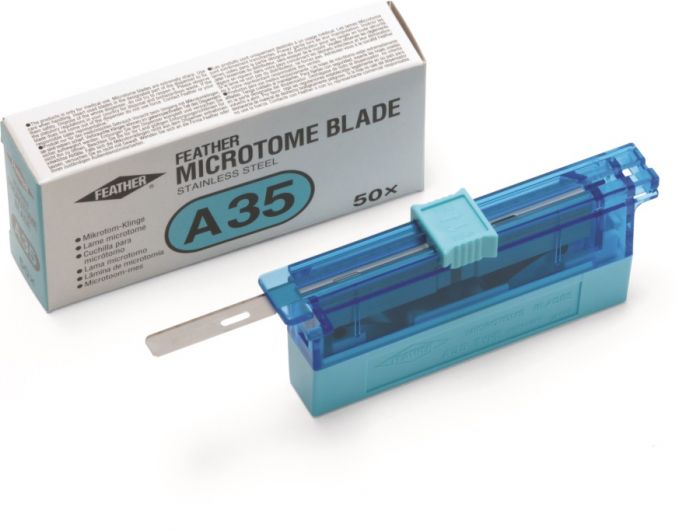
Microtome blade is a sharp cutting tool that is used to slice thin sections of tissue for microscopic examination. Microtomes are devices used in histology and pathology laboratories to prepare tissue specimens for examination under a microscope, and the microtome blade is a critical component of the microtome.
Microtome blades come in a variety of sizes and shapes, but they are typically thin, flat blades with a sharp edge. The blade is mounted onto the microtome and is used to slice the tissue into thin sections, which can be mounted onto glass slides for staining and examination under a microscope.
The choice of microtome blade depends on a number of factors, including the type of tissue being cut, the desired thickness of the sections, and the type of microtome being used. Some blades are disposable, while others can be resharpened and reused.
It is important to use a sharp and properly maintained microtome blade to ensure that the tissue sections are of high quality and can be accurately interpreted under the microscope. Dull or damaged blades can result in poor quality tissue sections, which can make it difficult to make an accurate diagnosis.
There are several types of microtome blades available, each with its own advantages and disadvantages. The most common types of microtome blades are:
Disposable blades: These are the most commonly used blades in histology and pathology labs. They are typically made of high-quality stainless steel or tungsten carbide and are designed for single-use only. Disposable blades are easy to use and provide consistent results, but they can be more expensive than other types of blades.
Resharpenable blades: These blades can be resharpened and reused multiple times, which can make them more cost-effective in the long run. However, they require regular maintenance and sharpening to ensure that they provide optimal cutting performance.
Low-profile blades: These blades are designed for cutting hard or frozen tissues and are thinner and sharper than standard microtome blades. They are ideal for cutting bone, cartilage, and other hard tissues.
High-profile blades: These blades are thicker and sturdier than standard microtome blades and are designed for cutting soft tissues, such as brain or liver. They provide more support for the tissue being cut and can produce thicker sections.
Diamond knives: These blades use a diamond edge to cut tissue sections and are typically used for ultra-thin sections required for electron microscopy. They are expensive and require specialized maintenance, but they can provide exceptionally high-quality sections.
The choice of microtome blade depends on the type of tissue being cut, the thickness of the sections required, and the specific requirements of the laboratory.
One important factor is the blade angle. Microtome blades can be angled differently, with the most common angles being 35°, 45°, and 60°. The angle of the blade affects the cutting force required and the quality of the sections produced, so the choice of angle will depend on the specific requirements of the laboratory.
Another factor to consider is the blade holder. The blade holder is the part of the microtome that holds the blade in place and allows it to be adjusted for different cutting angles and thicknesses. There are several different types of blade holders available, including the standard knife holder, disposable blade holder, and the rocking microtome blade holder.
It's also important to note that the choice of microtome blade can affect the speed and efficiency of the tissue sectioning process. For example, some blades may require more pressure to cut through certain types of tissue, which can slow down the process and potentially damage the tissue. Additionally, some blades may require more frequent sharpening or replacement, which can also impact the speed and efficiency of the sectioning process.
Overall, the choice of microtome blade will depend on a variety of factors, including the specific tissue being cut, the desired section thickness, the angle of the blade, and the type of blade holder being used. It's important to choose a blade that provides consistent and high-quality results while also being efficient and easy to use.
One important consideration when choosing a microtome blade is the material it is made of. The most commonly used materials for microtome blades are stainless steel and tungsten carbide.
Stainless steel blades are typically less expensive than tungsten carbide blades, but they may not maintain their sharpness as long and may need to be replaced more frequently. They are suitable for cutting softer tissues, but may struggle with harder tissues.
Tungsten carbide blades are more durable and maintain their sharpness longer than stainless steel blades. They are ideal for cutting harder tissues, such as bone and cartilage, and can also be used for cutting frozen tissue sections. However, they are more expensive and may require special maintenance and handling to prevent damage.
Another consideration is the shape of the blade. Most microtome blades are rectangular in shape, but some are triangular or have other shapes. The shape of the blade can affect the quality of the tissue sections produced and may be chosen based on the specific needs of the laboratory.
The thickness of the blade is also an important consideration. Thinner blades are generally better for producing thinner tissue sections, but they may be more fragile and prone to breaking. Thicker blades are sturdier, but may produce thicker tissue sections that are more difficult to examine under a microscope.
Finally, it's important to properly maintain and handle the microtome blade to ensure that it remains sharp and produces high-quality tissue sections. This includes regular cleaning and sharpening of the blade, as well as proper handling and storage to prevent damage or contamination.